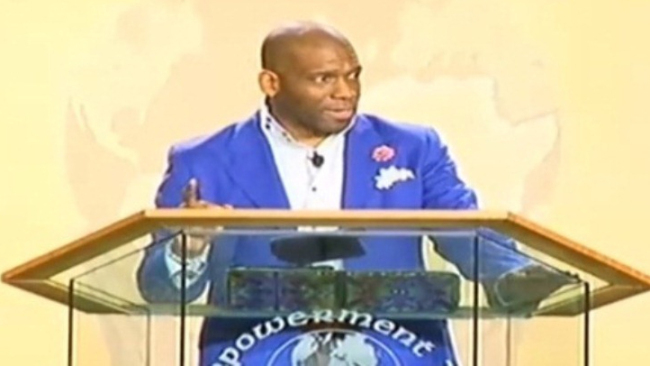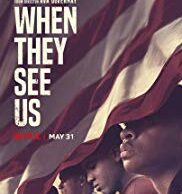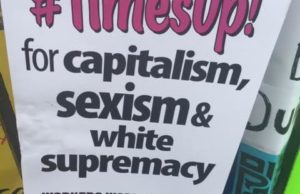It’s Bigger Than Jamal Bryant…
We interrupt our summer break to bring you this article, in light of recent events within black religion and black popular culture. This is not breaking news. However, in view of the interview that I did on Huff Post Live yesterday, I thought an expansion of context was immediately necessary.
Recently, in a sermon to his predominantly black congregation, pastor Jamal H. Bryant appropriated troubled singer Chris Brown’s song, Loyal. To be sure, using any of Brown’s music in a context that claims to empower mostly black female congregants through “the Word” is questionable. Bryant’s use of the popular in sacred space isn’t novel. The Black Church and black folk have long remixed black religion with black popular culture. Just visit the black religio-cultural archives and check out Thomas A. Dorsey, James Cleveland, C.L. Franklin, Kirk Franklin, and many others. Bryant stands within a long line of black preachers who deploy pop cultural products in religious space (and vice versa) in efforts to not only “make it plain” and “bring it home,” but to further mass mediate certain messaging that listeners may instantly connect to.
Simultaneously, Bryant stands in a long line of repeat offenders—those who use the sermonic moment in black churches to draw upon, reproduce, and maintain the cultural myth of black female hypersexuality. Among other things, in a 40 second sermon clip Bryant invokes the spirit of Chris Brown and exclaims, “these ho’s ain’t loyal!” Before going forward, I want to explicitly state that there is nothing redeemable or life giving about Bryant’s appropriation of Brown’s lyric. However, I do think it is important to think about 1) Bryant’s use of the lyric, 2) the audience response, and 3) Bryant’s privilege to deliver such a message in the first place within the Black Church context. Context does not excuse foolery, but it does matter. It matters in that it helps us to better understand both what’s happening and what’s at stake. Somebody tap your neighbor and say, “This is bigger than Jamal Bryant.”
Context Matters
What I hoped to engage in an interview on this matter on Huff Post Live yesterday was the importance of reading Bryant’s use of Chris Brown, his sermon in general, and the audience response, in light of the broader context of the Black Church, the black male preacher, the black church sermon, and the nuanced relationship between black male preachers and female congregants. My intention here is not to construct an “orient” but to provide greater context.
First, the historic Black Church has long been a site of both salvation and damnation. There is a long twisted history of mixed liberatory and oppressive messages, particularly for black women. Womanist theological scholars such as Kelly Brown Douglas, Cheryl Townsend Gilkes, Marcia Riggs, and others offer an expansive body of critical literature on the Black Church’s duplicity regarding sex and gender. In short, the Black Church has historically been hard on racism and soft on sexism.
Second, when thinking through Bryant’s performance and the audience response, it is imperative to note that the black male preacher has historically and presently holds a distinguished position amongst many African Americans. To be clear, there is a long history of black female preachers. My emphasis on black male preachers is not to exclude black women but to bracket the role, significance, and challenges particular to some black men. Also, all black male preachers are not the same. They are different, nuanced, and complex. Yet history reveals patterning that requires critical addressing.
Simultaneously, not all African Americans are religious. Yet, many are. A Gallup poll taken in 2012 stated that most of America is not only religious but largely Christian.[1] And, according to an American Religious Identification Survey (ARIS) survey[ii] released in 2009, conducted from February to November 2008, despite growing trends toward atheism and other belief systems, 86% of African Americans self-identified as Christian. Importantly, 55% of those surveyed for Gallup believe religion provides answers to most of today’s problems.
This is important when thinking about the power and influence of the black male preacher who, as Hortense Spillers notes, has historically been seen as community leader, authority figure bestowed with the divine power and knowledge to address the human condition, healer, teacher, judge, and even father. All of this, coupled with ubiquitous heteropatriarchy, grants the black male preacher a significant amount of power and influence. At times this has been used for good, and at other times, for bad.
Third, despite its contradictions, the Black Church sermon has served as a significant source of affirmation and insight where different needs may be answered and problems may be reimagined. Historically, the black sermon [often] enabled the actualization of critical consciousness and agency necessary for cultivating and realigning cultural meanings and identities, thus stimulating ideas of hope and transcendent possibilities. The preacher, both female and male, creates an ethos through the sermonic moment where folk can speak their truth and feel valued in many ways. However, simultaneously, sermons sometimes make their points by problematically placing black women on a pendulum between whoredom and sainthood.
Fourth, the historical relationship between the black male preacher and black female congregants is winding and complex. Admittedly, this topic demands more time and space than I can offer here. But it is a well-known fact the black male preacher has also been lover…and/or assailant. This is interesting to think about particularly within the context of North American slavery, broken kinship ties, breeding and forced incest, often confused sexual relations after slavery, pervasive fatherlessness, black American displacement, racism, sexism, hetero-patriarchal power, and more. History tells us that there has long been [misplaced] sexual tension and/or arrangements between pastors and congregants, beyond the Black Church, but certainly inclusive of it.
What cannot be ignored is how the positioning of black male preachers as “father” and female congregants as “daughters” establishes a hierarchal power arrangement, structured in dominance, which aligns, distributes, and exercises authority in particular ways, sometimes creating space for psychological, emotional, and sexual harm. Of course, not all pastors have sex with their congregants and not all sex is harmful and/or unconsented to. To be fair, the role of the black male preacher is simultaneously seductive for many. As with rock and rap stars, some spend their careers staving off sexual encounters. Others give in. And others don’t give up. That is, they pursue until they get what they want. The issue I mean to highlight here, however, is how patriarchal power within black churches has enabled a context of rhetorical, psychic, and existential harm.
Jamal Bryant
Bryant fits within this context. He is a third-generation AME pastor whose grandfather was a very prominent bishop in the AME church, a graduate of Morehouse College, and a product of Duke Divinity School. Further, content problematics aside, he is a gifted orator skilled in not only black preaching but politics. I think it’s also important to note that he started his church, Empowerment Temple, with just 43 members in 2000 and has grown it to over 10,000. This is no small feat, especially within the urban context of Baltimore.
The church’s mission is “Empowering the world through the Word.” Thus it has over 60 ministries some of which are committed to HIV/AIDS, the penal system, and domestic violence. For many people, Bryant meets certain needs. In addition, his connectivity to and interest in youth, Hip Hop, and entrepreneurship should not be overlooked. Each highlight why many find Bryant’s preaching and ministry attractive. In his own way, Bryant acknowledges the humanity of those often forgotten. And it doesn’t hurt that his followers see him as one of them.
What does hurt, however, is how Bryant, like others, at times misuses his platform. “I Am My Enemies’ Worst Nightmare” evidences the latter. Over the years I’ve heard a range of Bryants’ sermons, both in person and online, and for both pleasure and research purposes. Though Bryant has preached a range of sermons over time, “I Am My Enemies’ Worst Nightmare” seems to align with his preaching style, content, and methodology. And though it is important to ask what’s different about this moment, I’ll leave that to others. What I want to attend to is the context in which Bryant constructs a sermonic moment that is simultaneously life affirming and caring, and sexist, heterosexist, patriarchal, and homophobic—and why this matters.
When discussing the congregational response, it’s imperative to hold in tension Black Church history and culture, the black male preacher, the sermonic moment, and the ways in which Bryant charismatically weaves together a winding narrative about the systemic and structural destruction of black humanity. He opens with several important points about the necessity of affirming black life, how the killing of black male children is so common that it no longer gives us pause, how the educational and penal systems entwined marginalize black folk and limits thriving, and how black boys only get educational opportunities when bouncing basketballs and footballs. Though Bryant does not center how these same societal issues affect black women and girls, and though some of his points seemed to construct girl v. boy binaries, his attempt to affirm black humanity is important and should not be lost.
Unfortunately, he does this while throwing black women and girls and LGBTQI folk under the bus. In addition to pathologizing same-gender love as symptomatic and representative of black women and men being under attack, he tells the congregants that men are thinkers and women are feelers and that “real men” can be sanctified without becoming sissies. And just when you are ready to sign Bryant up for the nearest Gender Studies course, he draws on the theatrics of Tyler Perry and T.D. Jakes, who are notably masters of performing pseudo-feminism in religious space. That is, in the same sermon that exclaims “these ho’s aint loyal,” Bryant draws women in by talking about women and rising prison rates, socio-political attacks on young black girls, emotional abuse, and the suffrage movement and women’s right to vote and own property.
Though he wrongly and irresponsibly reduces the socio-political marginalization of black women and girls to the “rise of lesbianism,” and though his turn to “women talk” falls flat due to legless-ness, and in terms of the suffragists, outright rhetorical confusion, he does attempt to highlight the social positioning of black women and girls. It was significant when he told the congregants to turn to their neighbor and say, “They’re after our daughters.” Make no doubt about it, Bryant’s gender politics need a complete overhaul. But when we ask why many of the women in the video are standing and high-fiving at questionable points, we must read within context to include the work that Bryant does to speak to their particular situatedness.
Similarly, we cannot ignore how he, in-between problematizing black women’s existence in other ways, affirms them as women with dreams, purpose, and relational and Christian value. He also critiques black men who fail to see women in this way. This, along with Bryant’s critique of “ho’s” and “side chicks,” seemed to resonate with a lot of women—both in the video and outside of it. It is important to sit with the “why” question here. What does it mean for someone in Bryant’s position to speak a life-affirming message, even if only partially, to those often interpreted as the ratchet of the earth? What does it mean for him to acknowledge them as dreamers, even if dreaming seems limited to heteropatriarchal domesticity and partnership? What does it mean for Bryant to critique not only “the other woman,” but also straying men?
One day, we’ll need to deal honestly with the omnipresent desire of many black women to be in committed heterosexual relationships with black men. To be sure, our desires differ. But let’s be clear, Tyler Perry is the richest man in Hollywood because he caters to an overwhelming desire for black hetero, and yes sometimes patriarchal, partnership. Bryant taps into this model and in doing so, he provides hope for many in his audience. Not only that, he offers vindication and talk about the sufficiency of God’s grace and promises of God’s protection, despite pain and disappointment. For many women, this is good news. And no, black women aren’t duped. They are cultural readers who know how to take what they need and discard the rest. Though at times, these messages are so pervasive they get internalized. Still, even internalized messaging may be resisted. And black women resist and consent in all kinds of ways.
A Few Final Thoughts
While I want to resist completely dismissing Bryant’s message and more importantly, the value some may have found within it, I want to make it clear that talking about women does not equate to having a feminist politic. Feminist politics urges us to critique sexism and the ways in which it functions in tandem with racism, classism, and sexual and other oppressions. Several aspects of Bryant’s sermon were unequivocally sexist, homophobic, and heteropatriarchal. Feminist and womanist critique is necessary, and not just of Bryant but of the culture that produces, reproduces, maintains, and rewards Byrant and others with similar messaging—and punishes those who take a different route. He is neither the first nor the last, nor the best or the worst to linguistically violate black listeners. And to be clear, these offenses are not particular to the Black Church or black people. They are indicative of our culture and religion at large. Still, none of this lets Bryant and others following in his footsteps off the hook.
We need to deal honestly with the ways in which black folk continue to use the master’s tools to create and mass produce oppressive texts and contexts. And we cannot continue to ignore the existential and rhetorical violence that happens between the pulpit and congregation. We need to acknowledge the ways that linguistic violence creates a pathway for lived violence—within and beyond the church. For starters, ho language and ideology in black communities, culture, and churches needs to go. To put it simply, “ho” is a social construction. It doesn’t exist in reality. In addition to being sexist, ho language and ideology cuts women and girls off from community and safety and re-reads black female sexuality in terms of pathology, primitivism, difference, impurity, immorality, boundlessness, and danger. Further, it marks them as “flesh”—and historically, black female flesh was marketed for purchase, play, consumption, and disposal, thus making black women subject to everything and everyone.
We can no longer turn our backs on the ways in which women’s sexuality is framed as promiscuous and men’s sex [with women] is framed as evidence of acceptable masculinity. We also cannot ignore how the constant emphasis on women’s promiscuity in black churches—as in problematized sexuality—is not only juxtaposed against the preacher’s moral right but that of black men in general, thus making sexual conquest a right and black female sexuality a pathology. Simultaneously, we cannot ignore how this messaging impacts our present context where 250+ Nigerian girls are still missing and sex trafficking is steadily increasing. Problematizing women’s and girls’ sex and sexuality aids in lessening the sting of these epidemics and others.
The short of it is, black women and girls matter. This is not antithetical to the reality that black men and boys matter, too. We need an accountable, honest, and ethical intervention that creates space for critical listening and engagement, and we need the courage to re-interpret our identities outside of those projected in Modernity. They aren’t working for any of us. Because at the heart of all of this is all of us—real people with real lives and real needs.
To view the Huff Post Live interview, visit the following link: Prominent Pastor Under Fire For Chris Brown Lyrics.
[i] “Gallup Historical Trends: Religion,” Gallup, http://www.gallup.com/poll/1690/Religion.aspx.
[ii] Ariela Keysar and Barry A. Kosmin, “American Religious Identification Survey 2008,” Aris Reports, http://b27.cc.trincoll.edu/weblogs/AmericanReligionSurvey-ARIS/reports/p3a_race.html.
Much of this article was significantly informed by my previous and forthcoming works.





4 Comments